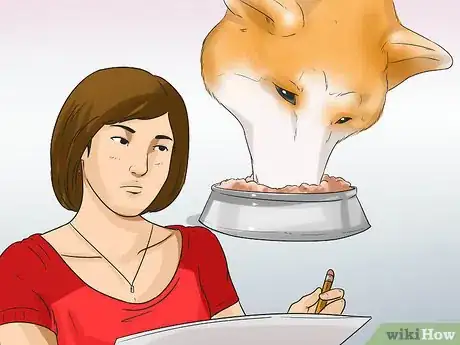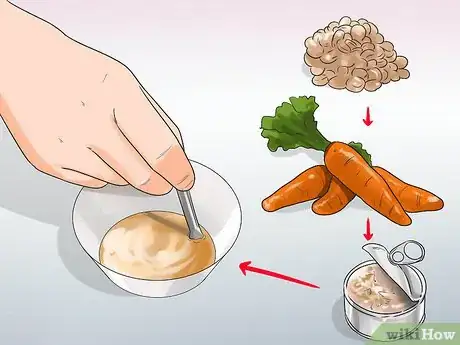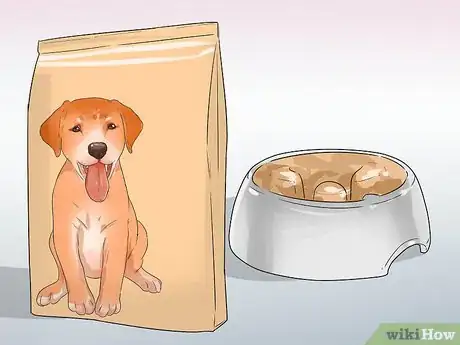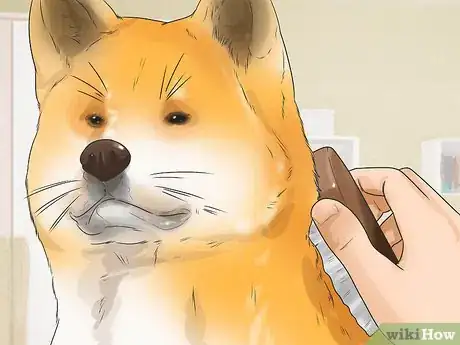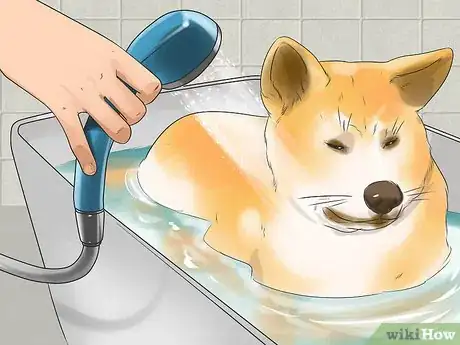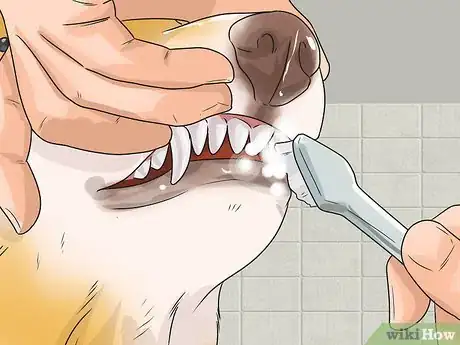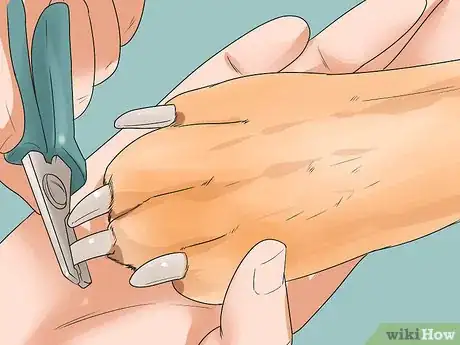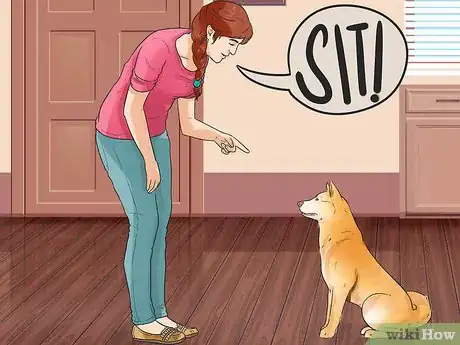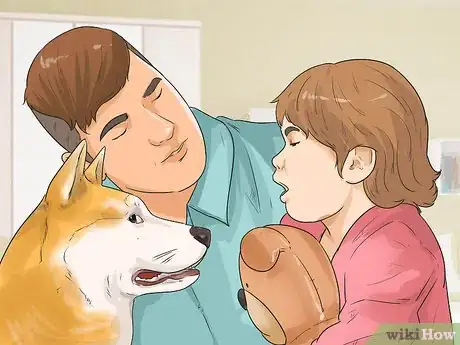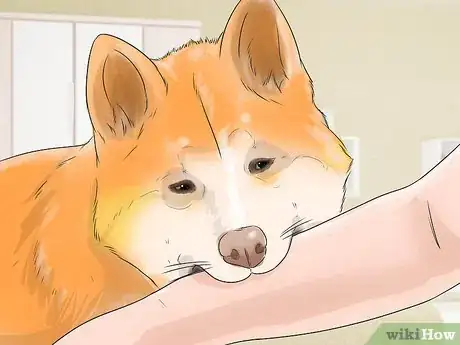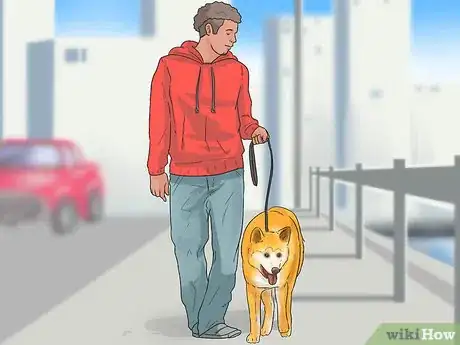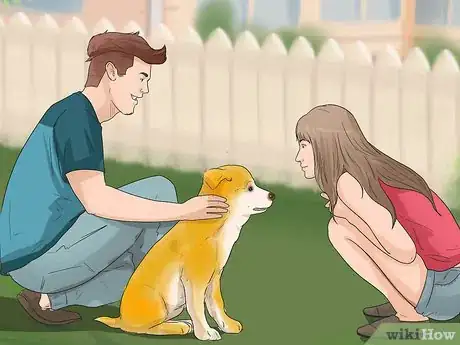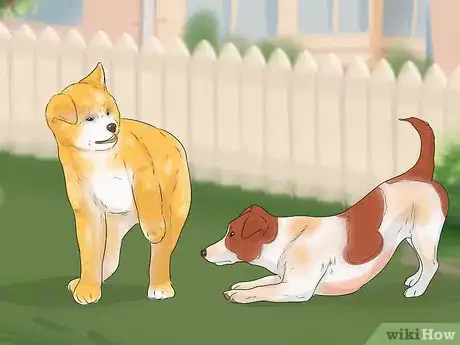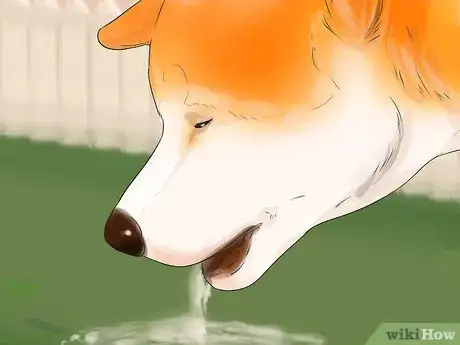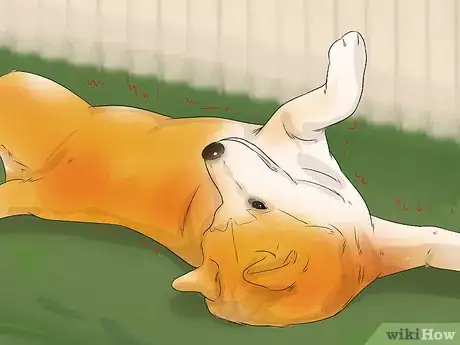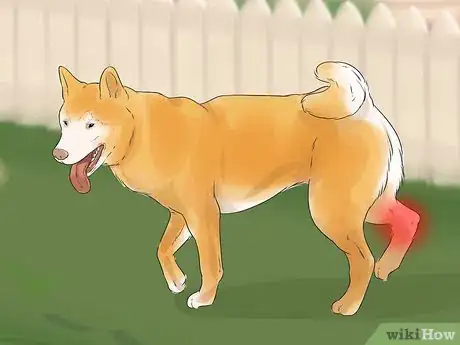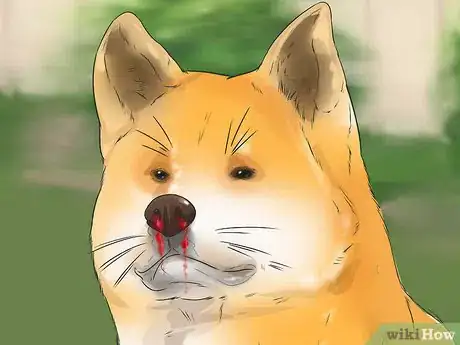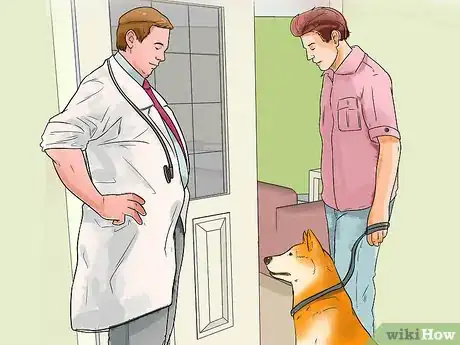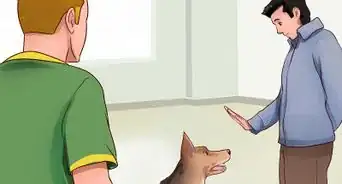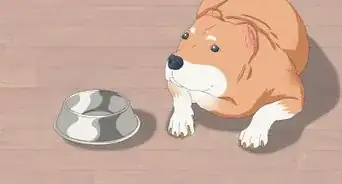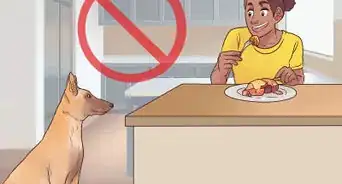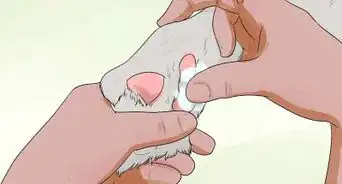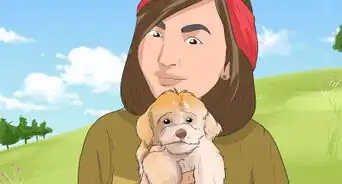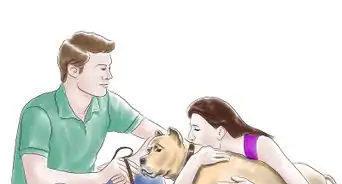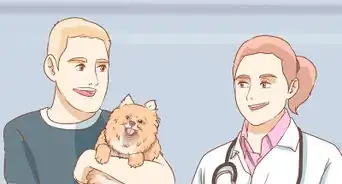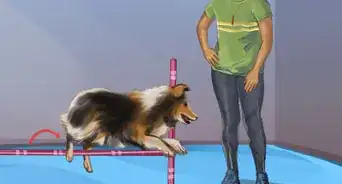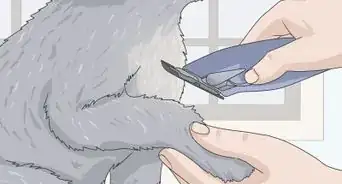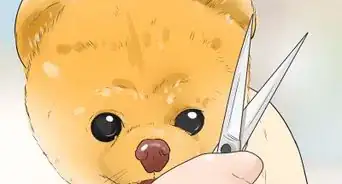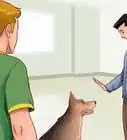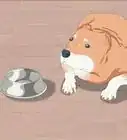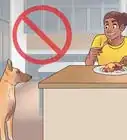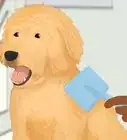This article was co-authored by Pippa Elliott, MRCVS. Dr. Elliott, BVMS, MRCVS is a veterinarian with over 30 years of experience in veterinary surgery and companion animal practice. She graduated from the University of Glasgow in 1987 with a degree in veterinary medicine and surgery. She has worked at the same animal clinic in her hometown for over 20 years.
There are 12 references cited in this article, which can be found at the bottom of the page.
This article has been viewed 37,316 times.
The Akita Inu is the original Japanese Akita. It is the dog from which the American Akita, now recognized as a separate breed, was derived. The Akita Inu is a medium-sized Spitz type dog that needs moderate exercise and is prone to certain medical problems.[1] With proper care, you can enjoy years of companionship from this affectionate breed of dog.
Steps
Feeding Your Akita Inu
-
1Create a feeding schedule. Akita Inu dogs have a powerful appetite. Feeding them properly is key to preserving good health. An Akita Inu should be fed two meals a day. Weigh your dog and follow the recommended feeding instructions on the package of your chosen dog food.
- As with most dogs, it's a good idea to feed your Akita Inu at roughly the same times every day, once in the morning, once in the evening.[2]
- Do not feed the dog more than it will typically eat within 10 minutes of feeding.
- If you notice any major weight fluctuations, slightly adjust the quantity fed either up or down depending on whether the dog has lost or gained weight.
- Overfeeding your dog can result in bloat, a potentially fatal condition.
- Some Akita Inu owners believe the dog should made to fast once a week for its health and to reduce the risk of bloat. Fasting is thought to have a cleansing effect on the digestive tract. If you decide to try this, you may still give your dog small amounts of food, such as small pieces of fruit with the skin removed.[3]
-
2Mix dry kibble and wet ingredients. The best food for an Akita Inu is a high-quality kibble with one or fresh ingredients mixed in. Look for kibble rich in fish and poultry, avoid kibble with lots of wheat and/or soy. Mix in any of the following:
- Rice (be careful, some Akita Inu dogs have an intolerance to brown rice)
- Vegetables (carrots, peas, and cooked potatoes are best)
- Eggs (boiled, never raw)
- Yogurt (plain)
- Canned tuna[4]
- These fresh ingredients should make up about 25 percent of the calories your dog consumes.[5] To get the ratio correct, you will need to look at the caloric content of the dog's food and the fresh ingredients you are adding.
Advertisement -
3Use a special bowl. Ask at your local pet store for a bowl that will slow down the dog's eating. These dogs tend to eat fast, which is bad for digestion and can lead to bloat.
- Slow-feeding bowls have a shape the prevents the dog from gulping down all its food in a few bites.[6]
Grooming Your Akita Inu
-
1Brush the dog regularly. The Akita Inu's coat is short and stiff and needs to be brushed regularly. About once a week is adequate for most of the year.
- The breed sheds heavily twice a year, so be prepared to spend extra time grooming your dog during these seasons.
- When selecting a brush for your Akita Inu at the pet store, look for one that is appropriate for the dog's double coat. Generally, a slicker brush or a flexible pin brush works well for dogs with a double coat.[7]
- For most the year (i.e. when the dog is not shedding), pick the same day of the week and time of day to brush your dog. The Akita Inu has an excellent internal clock and will quickly come to recognize brushing as a "fact of life" if you are consistent. This goes double if you can start this regimen when the dog is still a puppy.
-
2Bathe the dog sparingly. The Akita Inu's hair contains heavy oils that are necessary for repelling water. Take care not to strip these healthy oils from the coat by bathing too often.[8]
- Additionally, Akita Inu dogs will lick themselves clean like a cat. This keeps the dog clean and eliminates odors, making frequent bathing unnecessary.
- A bath every three to four months is typically adequate. Of course, if your dog plays in the mud or otherwise gets very filthy, a bath is in order, even if it has had one fairly recently.
-
3Brush the dog's teeth. The Akita Inu requires regular tooth brushing. Buy a dog toothbrush and toothpaste and clean its teeth twice a week. As best as you are able, brush the dog's teeth just as you would brush your own.[9]
- Failing to do this can result in periodontal disease, bad breath, and discomfort when your dog eats.
- Your local pet store should carry toothbrushes and toothpaste for dogs. If need be, do some trial and error to find a flavor your dog likes. Never use human dental products on a dog. Human toothpaste, in particular, can sicken a dog.
-
4Trim the dog's nails. These dogs need their nails trimmed once a month. Starting this regimen when the Akita Inu is still a puppy will make it more cooperative when it's time to trim.[10]
- It is very easy to accidentally cut a dog's nails too short, cutting into the quick. This causes bleeding and discomfort for your dog. To begin with, cut off only very small parts of the nail, until you get a better sense of what you are doing.
- Pet stores sell special nail cutters for pets with a guard built in that prevents cutting off a large amount by accident.
- If you are unable or unwilling to handle this yourself (e.g. because the dog is uncooperative or you are worried about cutting too much), have a professional groomer cut your dog's nails.
Training and Socializing Your Akita Inu
-
1Establish dominance. The Akita Inu can be a willful, even stubborn dog. if you want it to obey and respect you, you must establish your dominance over it early. Otherwise, it can become aggressive and disrespectful.
- Teach your Akita Inu to sit, stay, and come, providing it a treat when it does these tasks correctly. Do not treat the dog until it obeys your command. Require it to carry out one of these tasks before you give it a meal. This establishes that you are in control of the dog's food.
- Because this breed of dog is very willful, you should expect this training process to take a bit longer than it would with some other breeds. The key is persistence, consistency, and patience.
- Get other people involved in this training process. That way, the dog understands that you, and others, are dominant.
-
2Socialize the dog with children. Children should also be involved in this training process if they are about 10-12 years old or older, commanding the dog to do treats and rewarding it for success.
- Younger children should be involved in feeding the dog and entering and exiting the home with it so they are not seen as subordinate by the Akita Inu.
- Children should be told to be kind and gentle to the dog, and to avoid loud noises or sudden motions when the dog is first being socialized. This reduces the risk of the dog being spooked or hurt by the children and responding aggressively.
- With particularly boisterous children, especially those that may not live in the same house as the dog, it is best to keep the Akita Inu on a leash when it first begins interacting with children.
- Akita Inu puppies are sometimes frightened of children. If you get a puppy, introduce the children gradually, letting the dog come to them when it is ready, and supervising all interactions between the child and the dog.[11]
-
3Correct mouthing. The Akita Inu has a tendency toward "mouthing," i.e. putting its mouth around your wrist, hand, or arm. This is not the same as biting, but is a troubling behavior that you should consider trying to stop.[12]
- Seek advice from a behaviorist on how to make your dog stop mouthing.
- Consider giving the dog a task that involves carrying something. Akita Inu dogs are decent retrievers and can be trained to get your newspaper or slippers for you.
-
4Exercise the dog regularly to avoid behavioral problems. The Akita Inu is an active dog. It can live well in a small space, provided it gets plenty of exercise. If it does not, it will develop behavioral problems, possibly becoming destructive.[13]
- It is recommended that the dog be given two long walks (i.e. about 30 minutes) every day.[14] If you have a yard the dog can run in at will, this is ideal, but not necessary. Do not lock the dog out in the yard if it wants to come in.
- Don't overdo it. Prolonged periods outside on hot days can cause stress and illness for your dog. Do not force it to spend too much time in direct summer sun, especially when exercising.
-
5Keep the dog stimulated and social. The Akita Inu is an intelligent and social animal. It will want to spend time with you and your family, and it will need varied playful activities to stay happy.[15]
- Give your Akita Inu plenty of affection, and make sure it has toys to play with and carry around the house.
- Long periods solitary inactivity in your home are more likely to promote destructive behavior. The Akita Inu is active and intelligent and will make up activities if it becomes bored. This might include trying to dig a hole in the floor or chew through the leg of a chair.
-
6Be wary of aggression toward other dogs. The Akita Inu can be aggressive toward other dogs, especially those of the same sex.[16] It is not advisable to walk them off leash.
- Because of this trait, the Akita Inu is best suited to a one-dog household. It may also chase cats and other pets.
- If your Akita Inu appears hostile toward another dog, do your best to keep it away. If you cannot, and the dogs fight, grab your dog's back legs. Have another person grab the other dog's back legs, and back them away from each other as if each dog were a wheelbarrow.[17]
Monitoring Your Dog's Health
-
1Be vigilant for signs of bloat. The Akita Inu is one of the most susceptible breeds when it comes to bloat, a painful and often fatal twisting of the stomach.
- Bloat is more likely to occur when a dog eats too fast or exercises too soon after eating.
- Signs of bloat include agitation, vomiting, refusing to drink, and swelling in the torso. If you suspect bloat, take your dog to an emergency veterinary clinic. Bloat can kill a dog in few hours.
-
2Look for signs of autoimmune hypothyroidism. A full 65 percent of Akita Inu dogs experience thyroid problems, which can affect the dog's ability to fight off disease. Get your dog checked for autoimmune hypothyroidism if you notice any of the following:
- Seizures
- Hyperactivity
- Severe and sudden weight loss
- Weakness
- Severe and rapid weight gain
- Sudden aggressive behavior
- Skin problems
-
3Watch for hip and leg problems. Akita Inu dogs are susceptible to hip dysplasia and luxating patella. These are both joint problems of the leg. Predisposition to these conditions is hereditary, and they may be brought on by jumping from too great a height or gaining too much weight. Seek care if you note the following:
- Limping or favoring other legs
- Yelping in pain whenever the dog makes a particular motion
- Yelping when being picked up in a particular way
- Running with an odd hopping motion
-
4Recognize other disease symptoms. While less common, there are other health conditions that can affect the Akita Inu. Take your dog to the vet if you note the following:[18]
- Nosebleeds, easy bruising, and blood in the stood or urine can be a sign of Von Willebrand's disease.
- A tilt to one side, balance problems, or walking in circles can be a sign of Vestibular Syndrome.
- A rusty discoloration to the dogs coat can indicate it is getting too much sun, which can be harmful to the dogs internal organs.
- Dry, scaly skin and hair loss on the head, neck, and back can be a sign of sebaceous adenitis.
-
5Take your Akita Inu to the vet regularly. Even if you don't notice any health problems, your Akita Inu, like any dog, requires regular trips to the vet. Bring your dog at least once a year for a full checkup.[19]
- When visiting the vet, make sure to ask about any unusual behaviors, whether the dog is up to date on its shots, whether it is a healthy weight, and if it needs any additional dental care.[20] If you've seen any signs of the health problems described above, always be sure to mention this.
- Expect to spend, on average, several hundred dollars a year on veterinary care, and budget appropriately.[21] If the dog has severe health problems, and when the dog becomes older, costs will increase, so it's a good idea to have an emergency fund set aside as well, unless you have pet insurance.
Warnings
- If you have any indication your dog has bloat, seek immediate care. A third of all dogs that get this condition die from it.⧼thumbs_response⧽
- Do not leave your dog alone with small children until you are certain that it is socialized to their presence. It can do serious harm to small children, especially if it sees them as subordinates.⧼thumbs_response⧽
References
- ↑ http://www.dogbreedinfo.com/a/akitainu.htm
- ↑ https://www.petfinder.com/dogs/dog-nutrition/how-often-to-feed-your-dog/
- ↑ http://www.101dogbreeds.com/akita-inu.asp
- ↑ http://dogs.animal-world.com/Working-Dog-Breeds/AkitaInu.php
- ↑ http://www.whole-dog-journal.com/issues/14_5/features/Improving-Your-Dogs-Diet_20260-1.html
- ↑ http://puppyintraining.com/does-your-dog-eat-too-fast-our-top-3-slow-feeder-dog-bowls/
- ↑ http://www.canismajor.com/dog/groom1.html#Tools
- ↑ http://www.terrificpets.com/articles/1026965.asp
- ↑ http://www.terrificpets.com/articles/1026965.asp
- ↑ http://dogtime.com/dog-breeds/akita
- ↑ http://www.terrificpets.com/articles/1026965.asp
- ↑ http://dogtime.com/dog-breeds/akita
- ↑ http://www.101dogbreeds.com/akita-inu.asp
- ↑ http://dogtime.com/dog-breeds/akita
- ↑ http://dogtime.com/dog-breeds/akita
- ↑ http://dogtime.com/dog-breeds/akita
- ↑ https://www.thedodo.com/yes-there-is-a-smart-way-to-break-up-a-dog-fight-1488888838.html
- ↑ http://dogtime.com/dog-breeds/akita
- ↑ http://dogs.animal-world.com/Working-Dog-Breeds/AkitaInu.php
- ↑ http://www.petmd.com/dog/care/10-questions-everyone-should-ask-their-veterinarian#
- ↑ http://www.vetstreet.com/our-pet-experts/what-it-really-costs-to-own-a-pet
About This Article
To care for an Akita Inu dog, feed it 2 meals a day, and carefully follow the feeding instructions on the dog food you use since Akita Inus are prone to overeating, which can lead to a serious condition called bloat. You should also brush your dog's fur once a week to keep it clean and get rid of loose hairs. However, you should only bathe your dog about once every 3-4 months since Akita Inus clean themselves and frequent bathing can strip their fur of its natural oils. Additionally, it's important that you take your dog to the vet regularly since Akita Inus are prone to thyroid problems and other health issues. For advice from our Veterinary co-author, like how to train and socialize your Akita Inu, scroll down!
